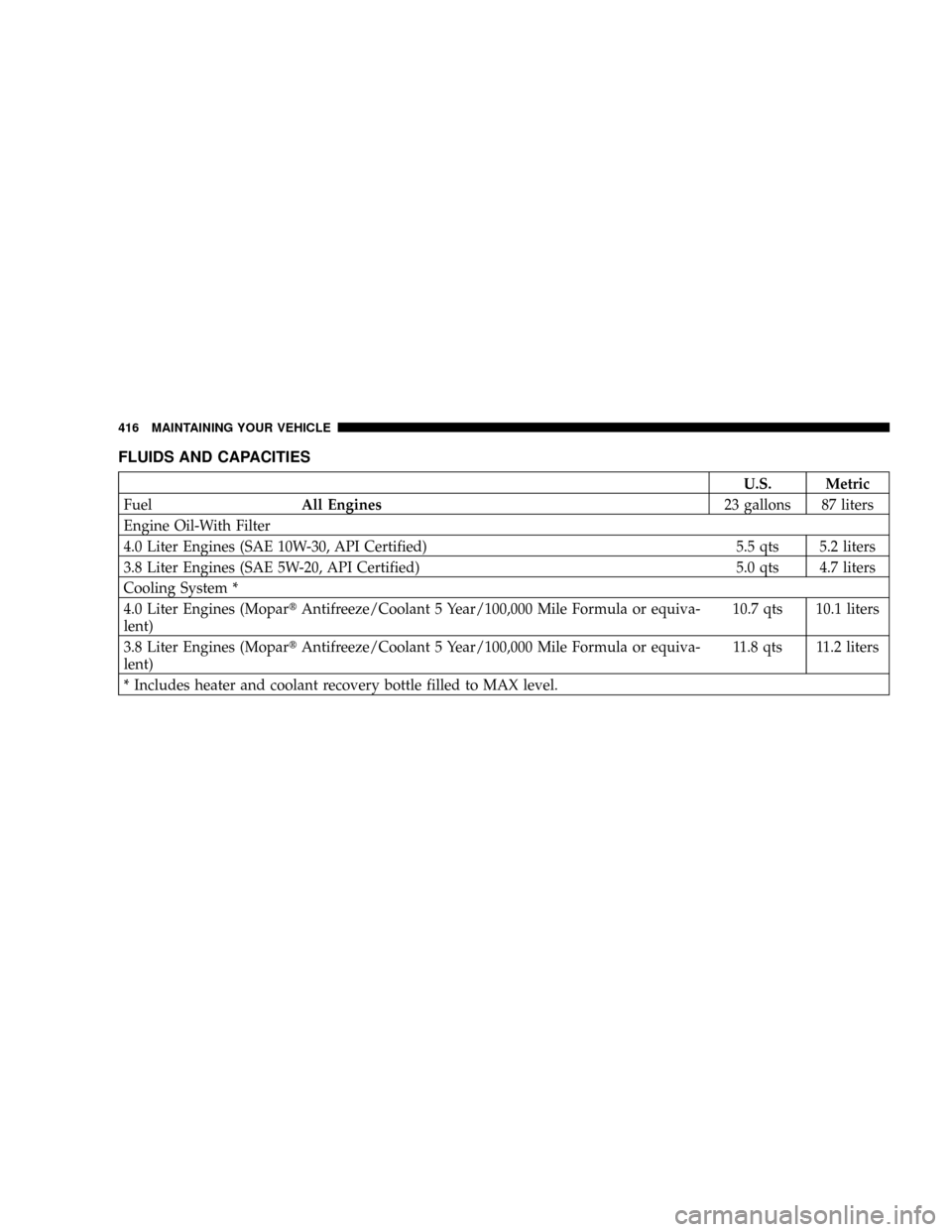2008 CHRYSLER PACIFICA coolant level
[x] Cancel search: coolant levelPage 188 of 457

WARNING!
A hot engine cooling system is dangerous. You or
others could be badly burned by steam or boiling
coolant. You may want to call a service center if your
vehicle overheats. If you decide to look under the
hood yourself, see Section 7 of this manual. Follow
the warnings under the Cooling System Pressure Cap
paragraph.
3. Fuel Gauge
The pointer shows the level of fuel in the fuel tank when
the ignition switch is in the ON position.
The Low Fuel Light will turn on when the fuel level
reaches approximately 2 to 4 gallons (7 to 15 liters)
this light will remain on until fuel is added.4. Turn Signal Indicators
The arrow will flash with the exterior turn signal
when the turn signal lever is operated.
If the vehicle electronics sense that the vehicle has
traveled about one mile with the turn signals on, a chime
will sound to alert you to turn the signals off. If either
indicator flashes at a rapid rate, check for a defective
outside light bulb.
5. Speedometer
Indicates vehicle speed.
6. Anti-Lock Brake Light
This light monitors the Anti-Lock Brake Sys-
tem. The light will turn on when the ignition
switch is turned to the ON position and may
stay on for as long as four seconds.
If the ABS light remains on or turns on while driving, it
indicates that the Anti-Lock portion of the brake system
188 UNDERSTANDING YOUR INSTRUMENT PANEL
Page 391 of 457

Adding Engine Coolant
Your vehicle has been built with an improved engine
coolant that allows extended maintenance intervals. This
coolant can be used up to 5 Years or 100,000 miles before
replacement. To prevent reducing this extended mainte-
nance period, it is important that you use the same
coolant throughout the life of your vehicle. Please review
these recommendations for using Hybrid Organic Addi-
tive Technology (HOAT) coolant.
When adding coolant, a minimum solution of 50% rec-
ommended Mopar Antifreeze/ Coolant 5 Year / 100,000
Mile Formula HOAT (Hybrid Organic Additive Technol-
ogy), or equivalent, in water should be used. Use higher
concentrations (not to exceed 70%) if temperatures below
234ÉF (237ÉC ) are anticipated.
Use only high purity water such as distilled or deionized
water when mixing the water/engine coolant solution.The use of lower quality water will reduce the amount of
corrosion protection in the engine cooling system.
Please note that it is the owner's responsibility to main-
tain the proper level of protection against freezing ac-
cording to the temperatures occurring in the area where
the vehicle is operated.
NOTE:Mixing coolant types will decrease the life of the
engine coolant and will require more frequent coolant
changes.
Cooling System Pressure Cap
The cap must be fully tightened to prevent loss of
coolant, and to insure that coolant will return to the
radiator from the coolant recovery bottle.
The cap should be inspected and cleaned if there is any
accumulation of foreign material on the sealing surfaces.
MAINTAINING YOUR VEHICLE 391
7
Page 392 of 457

WARNING!
²The warning words ªDO NOT OPEN HOTº on
the cooling system pressure cap are a safety pre-
caution. Never add coolant when the engine is
overheated. Do not loosen or remove the cap to
cool an overheated engine. Heat causes pressure to
build up in the cooling system. To prevent scald-
ing or injury, do not remove the pressure cap while
the system is hot or under pressure.
²Do not use a pressure cap other than the one
specified for your vehicle. Personal injury or en-
gine damage may result.
Disposal of Used Engine Coolant
Used ethylene glycol based engine coolant is a regulated
substance requiring proper disposal. Check with your
local authorities to determine the disposal rules for yourcommunity. To prevent ingestion by animals or children
do not store ethylene glycol based engine coolant in open
containers or allow it to remain in puddles on the
ground. If ingested by a child, contact a physician
immediately. Clean up any ground spills immediately.
Engine Coolant Level
The coolant bottle provides a quick visual method for
determining that the coolant level is adequate. With the
engine off and cold, the coolant level in the coolant
recovery bottle should be between the ranges indicated
on the bottle.
The radiator normally remains completely full, so there is
no need to remove the radiator cap unless checking for
coolant freeze point or replacing coolant. Advise your
service attendant of this. As long as the engine operating
temperature is satisfactory, the coolant bottle need only
be checked once a month.
392 MAINTAINING YOUR VEHICLE
Page 393 of 457

When additional coolant is needed to maintain the
proper level, it should be added to the coolant bottle. Do
not overfill.
Points To Remember
NOTE:When the vehicle is stopped after a few miles (a
few kilometers) of operation, you may observe vapor
coming from the front of the engine compartment. This is
normally a result of moisture from rain, snow, or high
humidity accumulating on the radiator and being vapor-
ized when the thermostat opens, allowing hot coolant to
enter the radiator.
If an examination of your engine compartment shows no
evidence of radiator or hose leaks, the vehicle may be
safely driven. The vapor will soon dissipate.
²Do not overfill the coolant recovery bottle.
²Check coolant freeze point in the radiator and in the
coolant recovery bottle. If antifreeze needs to be
added, contents of coolant recovery bottle must also be
protected against freezing.
²If frequent coolant additions are required, or if the
level in the coolant recovery bottle does not drop when
the engine cools, the cooling system should be pres-
sure tested for leaks.
²Maintain coolant concentration at 50% HOAT engine
coolant (minimum) and distilled water for proper
corrosion protection of your engine which contains
aluminum components.
²Make sure that the radiator and coolant recovery
bottle overflow hoses are not kinked or obstructed.
²Keep the front of the radiator clean. If your vehicle is
equipped with air conditioning, keep the front of the
condenser clean, also.
MAINTAINING YOUR VEHICLE 393
7
Page 416 of 457

FLUIDS AND CAPACITIES
U.S. Metric
FuelAll Engines23 gallons 87 liters
Engine Oil-With Filter
4.0 Liter Engines (SAE 10W-30, API Certified) 5.5 qts 5.2 liters
3.8 Liter Engines (SAE 5W-20, API Certified) 5.0 qts 4.7 liters
Cooling System *
4.0 Liter Engines (MopartAntifreeze/Coolant 5 Year/100,000 Mile Formula or equiva-
lent)10.7 qts 10.1 liters
3.8 Liter Engines (MopartAntifreeze/Coolant 5 Year/100,000 Mile Formula or equiva-
lent)11.8 qts 11.2 liters
* Includes heater and coolant recovery bottle filled to MAX level.
416 MAINTAINING YOUR VEHICLE
Page 422 of 457

²Check the fluid levels of coolant reservoir, brake
master cylinder, power steering and transmission and
add as needed.
²Check all lights and other electrical items for correct
operation.At Each Oil Change
²Change the engine oil filter.
²Inspect the brake hoses and lines.
CAUTION!
Failure to perform the required maintenance items
may result in damage to the vehicle.
422 MAINTENANCE SCHEDULES
8
M
A
I
N
T
E
N
A
N
C
E
S
C
H
E
D
U
L
E
S
Page 441 of 457

Console, Overhead....................... 168
Contract, Service........................ 430
Coolant Pressure Cap (Radiator Cap).......... 391
Cooling System......................... 389
Adding Coolant (Antifreeze).............. 391
Coolant Capacity...................... 416
Coolant Level......................389,392
Disposal of Used Coolant................ 392
Drain, Flush, and Refill.................. 390
Inspection........................... 392
Points to Remember.................... 393
Pressure Cap......................... 391
Radiator Cap......................... 391
Selection of Coolant (Antifreeze)......390,416,417
Cruise Control (Speed Control).............. 144
Cruise Light........................... 193
Cup Holder.........................174,406
Customer Assistance..................... 428Data Recorder, Event...................... 65
Dealer Service.......................... 375
Defroster, Rear Window................... 269
Defroster, Windshield................79,256,265
Delay (Intermittent) Wipers................. 141
Diagnostic System, Onboard................ 372
Digital Video Disc (DVD) Player............. 232
Dimmer Switch, Headlight................. 139
Dipsticks
Automatic Transmission................. 399
Oil (Engine).......................... 376
Disabled Vehicle Towing................... 363
Disposal
Antifreeze (Engine Coolant)............... 392
Engine Oil........................... 379
Door Ajar Light......................... 197
Door Locks............................. 26
Door Locks, Automatic.................... 27
Door Opener, Garage..................... 146
INDEX 441
10
Page 442 of 457

Drive Belts............................ 379
Drive Shaft Universal Joints................ 386
Driving
On Slippery Surfaces.................... 291
Through Flowing, Rising, or Shallow Standing
Water.............................. 292
DVD Player (Video Entertainment System)...... 232
Electric Remote Mirrors.................... 88
Electrical Power Outlets................... 172
Electronic Brake Control System............. 154
Brake Assist System.................... 154
Electronic Stability Program............... 155
Traction Control System................. 154
Electronic Speed Control (Cruise Control)...... 144
Electronic Stability Program (ESP)............ 155
Electronic Vehicle Information Center
(EVIC).............................166,199Emergency, In Case of
Hazard Warning Flasher................. 350
Jacking............................. 352
Jump Starting......................... 360
Overheating.......................... 351
Emission Control System Maintenance......373,420
Engine..........................77,370,371
Air Cleaner.......................... 380
Air Cleaner Filter...................... 380
Block Heater......................... 278
Break-In Recommendations................ 77
Checking Oil Level..................... 376
Compartment......................370,371
Coolant (Antifreeze).................... 417
Cooling............................. 389
Exhaust Gas Caution..................37,328
Flooded, Starting...................... 277
Fuel Requirements..................325,416
Oil ...........................376,416,417
442 INDEX